This was offered on an auction site and I bid on it and lost. Then it came back up for auction because the person who outbid me must have changed his mind. Usually if I get a second chance at something I'll take it (that's how I got my Philco Baby Grand).
Here's a photo of it from the website because my own photos are worse. Some time I'll pull it out where I can light and photograph it properly, but the meantime, this will have to do.
It was advertised as a Wards Airline, but that's actually because a previous owner gutted it and put a 70s era Monkey Ward receiver, complete with 8-track tape player, inside. Oh, the pain.
Nice needlepoint, but I don't know how it'll work as a grille cloth.
For a long time I had no idea what this was, but after a lot of poring over old books and magazines and internet photos, I believe it's a Crosley 410 Deluxe Console . American Radio History recently uploaded a 1927 copy of Radio Retailing, and there was this blurb about it (see ad below left).
I've looked at it hard and all styling cues are there: the legs, the skirt, the trim around the lower battery box, the decorative pieces on the doors. The veneer in image is a bit fancier, but I assume the veneer varied from unit to unit and they chose one of the prettiest for their ad.
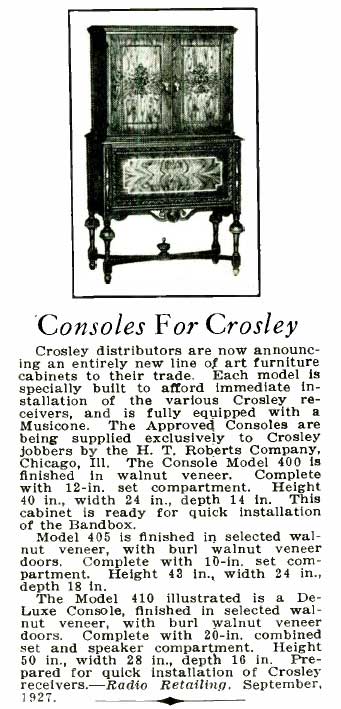 The copy describes three models, the 400, 405 and 410; the 410's dimensions match my cabinet.
The copy describes three models, the 400, 405 and 410; the 410's dimensions match my cabinet.
According to another advertisement (Radio News, June 1927), this cabinet was meant to take a Crosley Bandbox, which was a metal-cabinet, six-tube Neutrodyne (sold separately). It also took a Musicone speaker, which was already fitted into the cabinet; of course mine is long gone, so I'll have to come up with something to deal with that.
Found a Bandbox on eBay. Typical recent eBay purchase: it cost more to ship it than I paid for the actual set.
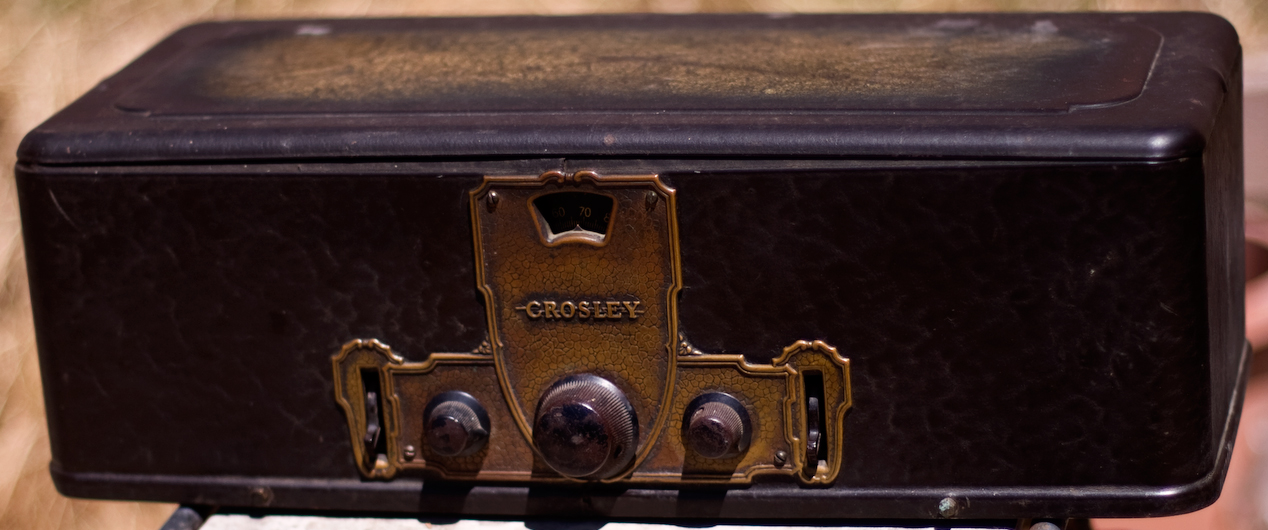 This is the set (click photos for larger images). It's a six-tube Neutrodyne: three 01As for the RF stages, another 01A for the detector, a fifth 01A for the first audio amp, and a 71A for the power audio out.
This is the set (click photos for larger images). It's a six-tube Neutrodyne: three 01As for the RF stages, another 01A for the detector, a fifth 01A for the first audio amp, and a 71A for the power audio out.
Mine came without tubes (of course), so it'll be expensive to outfit. Guaranteed good 01As are running about $50 each these days; 71As are about half that. I have a bunch of 01As but I doubt that six of them actually work.
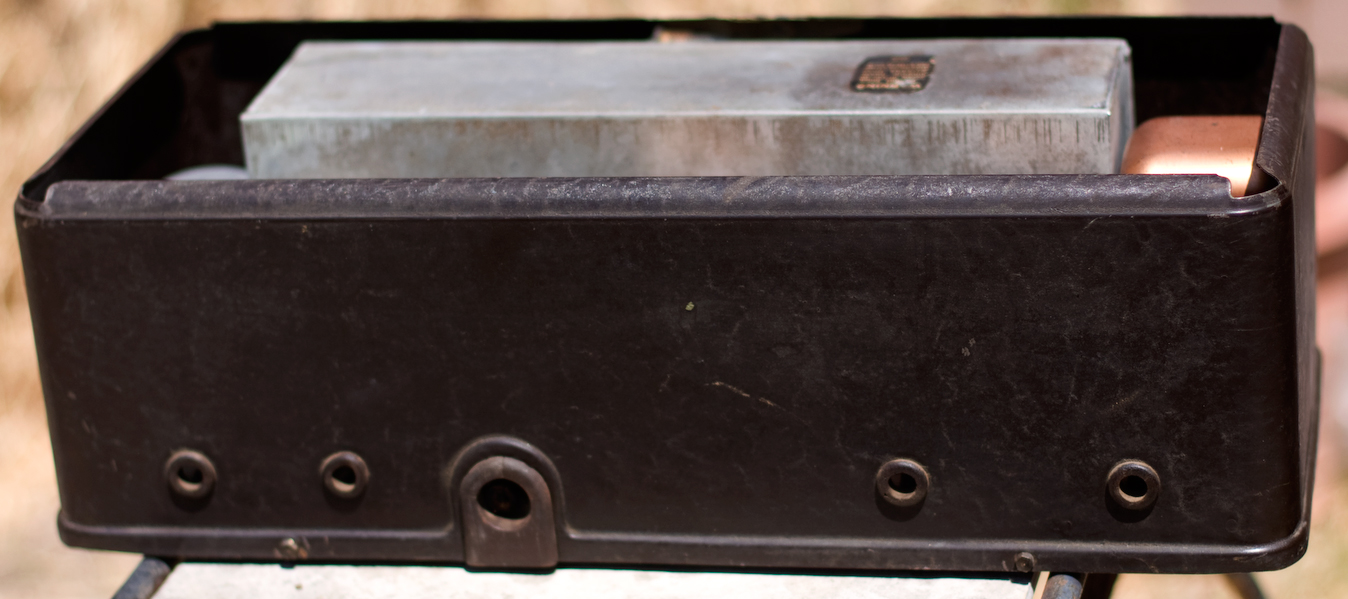 An aside for anyone who doesn't know: the literature at the time (late 1920s) call for UX-201-As or CX-301As (and the UX-171-A or CX-371-A). The U series is RCA's numbering scheme; the C-series is Cunningham's, and the tubes are equivalent, it's just the prefixes that changed. Cunningham was based in Oakland, California, and had a deal to produce General Electric's tubes. When RCA was created (with GE as one of the part owners), Cunningham because the west coast RCA entity. Through the 20s, most literature used the full tube's model numbering scheme; by the 1930s, this was dropped in favor of the last two digits, which is all that mattered anyway.
An aside for anyone who doesn't know: the literature at the time (late 1920s) call for UX-201-As or CX-301As (and the UX-171-A or CX-371-A). The U series is RCA's numbering scheme; the C-series is Cunningham's, and the tubes are equivalent, it's just the prefixes that changed. Cunningham was based in Oakland, California, and had a deal to produce General Electric's tubes. When RCA was created (with GE as one of the part owners), Cunningham because the west coast RCA entity. Through the 20s, most literature used the full tube's model numbering scheme; by the 1930s, this was dropped in favor of the last two digits, which is all that mattered anyway.
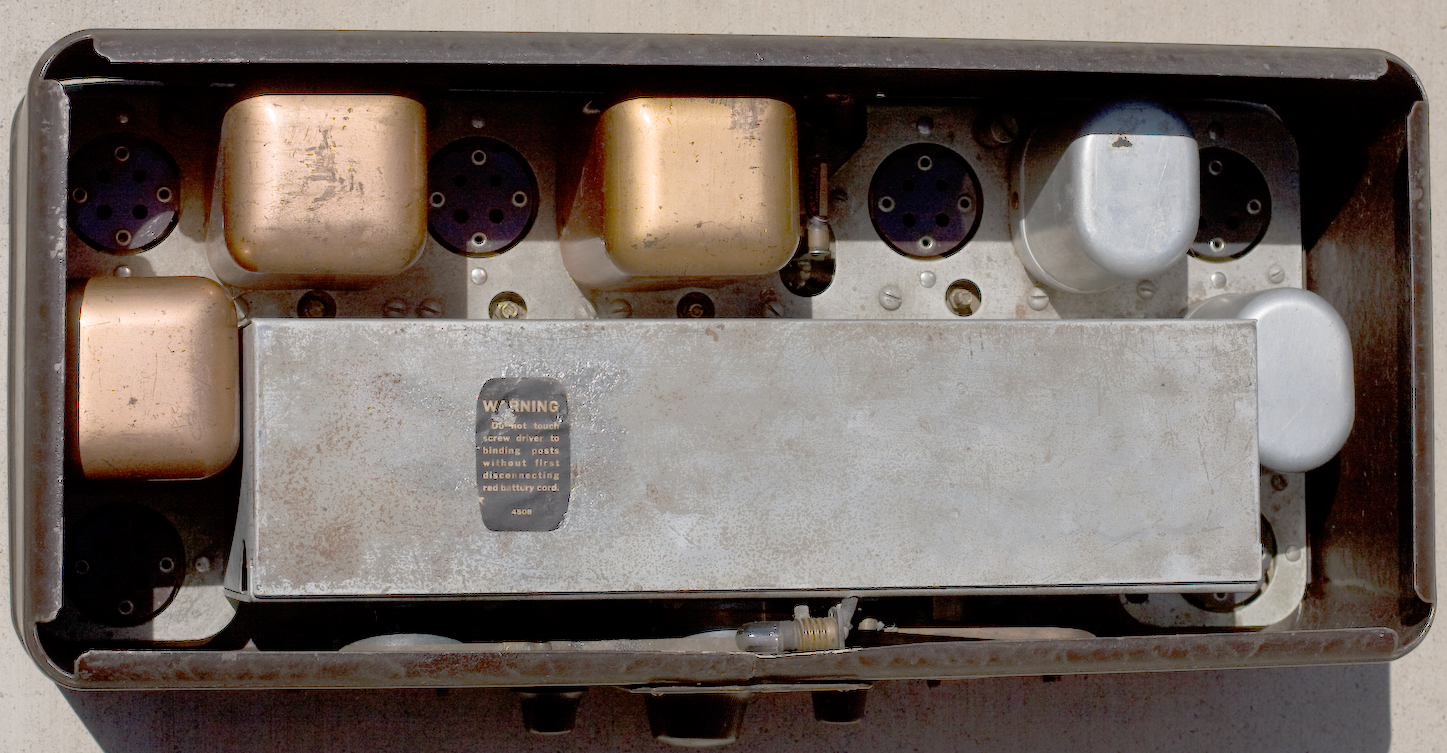 This is a neutrodyne, but it's a later version with one-knob tuning, thanks to two metal belts that synchronize the three tuning capacitors. It's also got a modern (for the 20s) vernier dial, which would become standard for the next few years until large clock-face dials took over.
This is a neutrodyne, but it's a later version with one-knob tuning, thanks to two metal belts that synchronize the three tuning capacitors. It's also got a modern (for the 20s) vernier dial, which would become standard for the next few years until large clock-face dials took over.
The cabinet is a metal box, first popularized (I believe) by Atwater Kent. The can was meant as a cost-savings device but it was suprisingly popular, and it did look more modern than the wood boxes (but I like wood cabinets better). Mine's got some "character" flaws but it's still in pretty nice shape considering it's 90 years old.
Inside (the top just lifts off) you can't see much because of the shielding. I haven't removed the chassis yet.
For repair documentation, there are two sources of which I'm aware. The first is everybody's friend, the Rider's Perpetual Troubleshooter Manual, Volume 1 (Crosley models 601 and 602—I'm not sure which one I have yet). Unfortunately, the Rider pages leave something to be desired, so there's also an article on a Bandbox restoration in The Flash, the newsletter of the Coloradio Radio Collectors Antique Radio Club. The Flash, Volume 25, #2 has a nice discussion of a restoration of a bandbox, and includes a much better, re-drawn schematic diagram. The schematic looks and prints small, but it holds up well when you zoom in on it.
The original Bandbox sold for $55 as a battery set. If you wanted to run it on newfangled AC out of the wall or a lamp socket, you'd need to buy their AC power supply for $65. So let's say you bought a Bandbox ($55), the AC power supply ($65), and the cabinet ($85)—that's $205 in 1928 money. Wow.
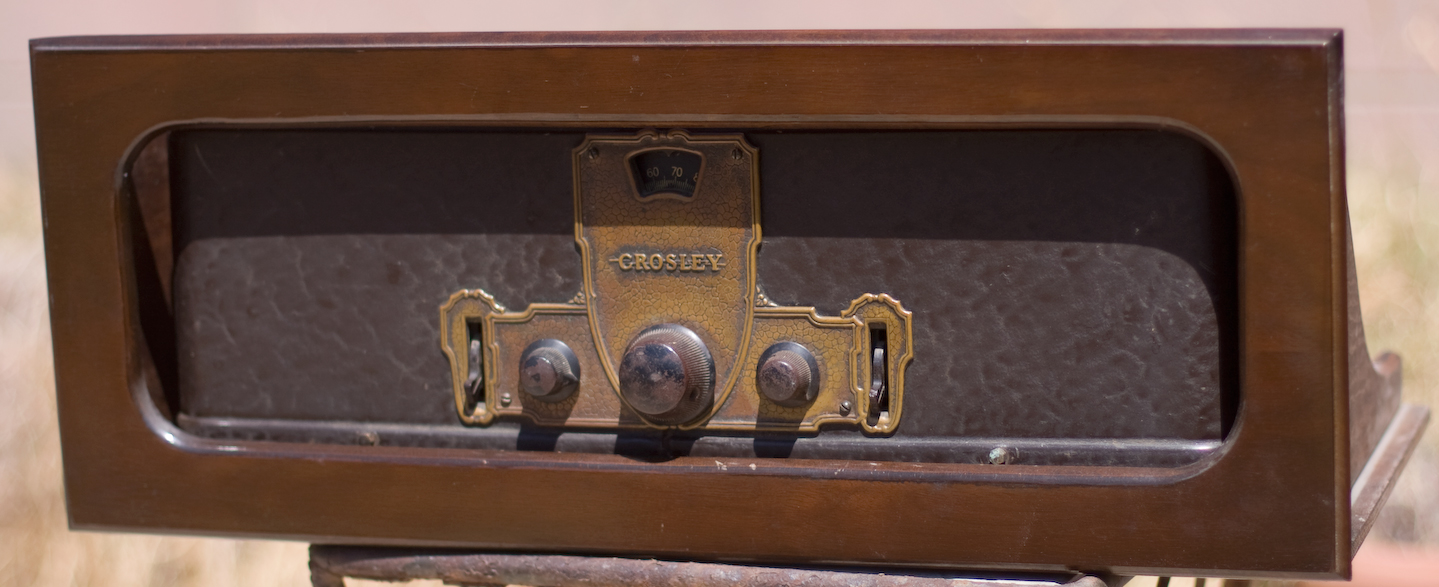 I'll admit that after looking at the docs, my enthusiasm for this project has gone cold. I'd have to make a battery elminator for the following voltages (assuming the schematic in The Flash is correct): 135V, 90V, 45V, 22-½V, 6V, -5-½V, and -27V. That's quite a lot of outputs.
I'll admit that after looking at the docs, my enthusiasm for this project has gone cold. I'd have to make a battery elminator for the following voltages (assuming the schematic in The Flash is correct): 135V, 90V, 45V, 22-½V, 6V, -5-½V, and -27V. That's quite a lot of outputs.
Then because some ass cut the power cord off, I'd have to rebuild the cord again. Not too difficult but time-consuming. Then I have to check the chassis out and see which components have to be repaired or replaced—and if mine is anything like the one in The Flash (and it likely is), that'll be a lot of work. And that just gets the Bandbox running.
 Then I have to fit the thing into the tray for my cabinet. Initially I had hoped that I could just set the metal cabinet in and it would work, but no such luck. The opening in the tray is too wide, so to do it properly, I'd have to make a blank face plate to fit into the opening of the tray, cut out holes for the dial and the controls, screw the escutcheon on it, and make a cradle to hold the chassis in place.
Then I have to fit the thing into the tray for my cabinet. Initially I had hoped that I could just set the metal cabinet in and it would work, but no such luck. The opening in the tray is too wide, so to do it properly, I'd have to make a blank face plate to fit into the opening of the tray, cut out holes for the dial and the controls, screw the escutcheon on it, and make a cradle to hold the chassis in place.
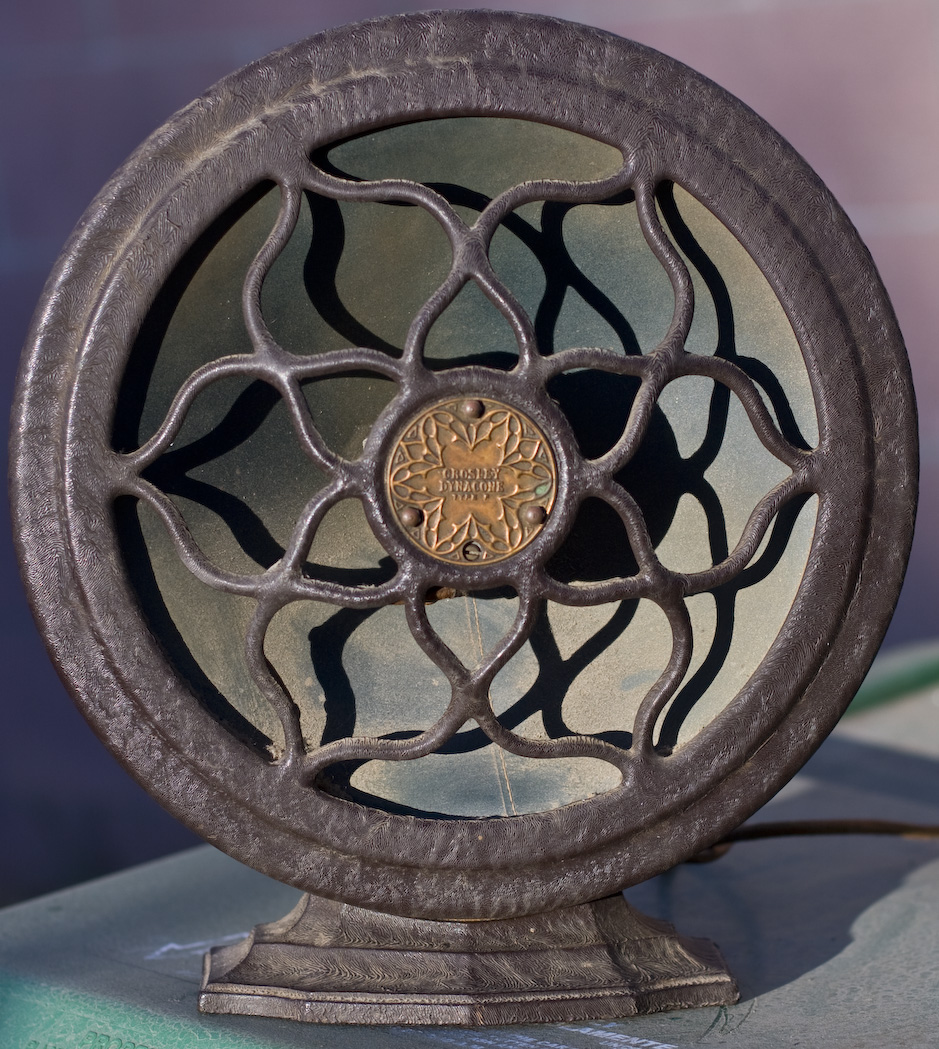 After that's done, I still have to come up with a speaker grille to fill the hole in the cabinet, get some grill cloth to go behind it (that shouldn't be a big deal), and then get a compatible speaker to mount.
After that's done, I still have to come up with a speaker grille to fill the hole in the cabinet, get some grill cloth to go behind it (that shouldn't be a big deal), and then get a compatible speaker to mount.
That's a lot of work. And I still haven't done anything with the many flaws and warts on the cabinet.
I take it this is going to be the kind of project I'll do in tiny bits and pieces between now and the end of the world.
I did get a Dynacone for it, but the metal case for it is too big to fit into the cabinet. To make it work, I'd have to remove the speaker from the case and custom mount it too. Ugh.
Current status: this radio is no longer in my collection. This page will be removed in late 2024.

.jpg)
.jpg)